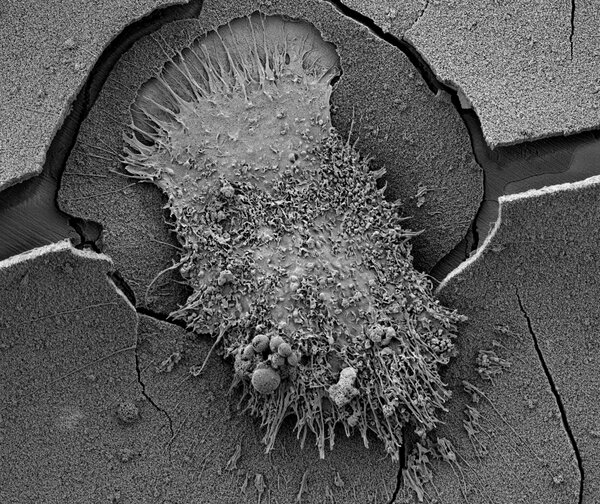
S53P4 bioactive glass (BAG) is a composition of BAG with bone-bonding and antimicrobial properties. When BAG gets in contact with (body) fluids it will start releasing ions, which can kill bacteria and provides a surface for calcium phosphates to precipitate on and the material becomes bone bonding. The degradation process of S53P4 BAG granules will have an influence on the material behaviour. Bone degrading osteoclasts resorb bone through interplay with a local low pH and enzymatic activity. To study the susceptibility of BAG to be dissolved in a low pH, BAG granules were immersed in two buffer solutions, one with a pH of 4.6, which is similar to the pH secreted by osteoclasts, and one with a physiological pH of 7.3. Ion release in the solution was measured by ion chromatography and showed seven fold higher calcium and four fold higher phosphate concentration in the buffer solution with pH 4.6 than with pH 7.3, after 7 days. Granules subjected to pH 4.5 showed a 4% weight loss compared to 1% weight loss immersed in pH 7.3. Scanning electron microscopy (SEM) and energy dispersive spectrography (EDS) demonstrated the precipitation of calcium phosphate (CaP) on the surface of BAG in both conditions.
To study cellular degradation of the formed HA layer on S53P4 BAG, monocytes were seeded on S53P4 BAG discs and dense HA discs with addition of macrophage-colony stimulating factor (M-CSF) and receptor activator of nuclear factor (NF)-κB ligand (RANKL) to induce osteoclasts differentiation. After 15 days of culturing, osteoclasts were observed on both dense HA discs and S53P4 BAG discs, using SEM. Real-time quantitative PCR (RT-qPCR) indicated an elevated expression of the osteoclast stimulatory transmembrane protein (OC-STAMP) and resorption enzyme CathepsinK (CatK). After 18 days of culturing, resorption pits were detected, indicating that osteoclasts were able to resorb the HA layer formed on the BAG surface.
The findings of the in vitro degradation of the HA layer formed on BAG by osteoclasts, might help to gain more insight in the in vivo degradation of BAG. This might eventually lead to a better remodelling and restoration of the defect and therefore the function of bone.